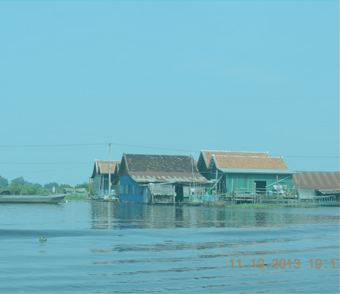The Mekong delta has been designated by the Intergovernmental Panel on Climate Change[1] as one of three mega deltas (with more than 1 million people) most threatened by coastal erosion due to sea level rise, along with the accompanying storm surges and salinity intrusion. Some 30% of this delta may be permanently lost. This is of particular concern because this delta is one of the most biologically productive in the world in terms of its capture fishery and aquatic biodiversity. It is also home to some 18 million Vietnamese and is the “rice bowl” of Southeast Asia, producing half of the rice of Vietnam and supporting the livelihoods for some 18 million Vietnamese and Cambodians who call it home.
The delta’s extraordinary productivity is directly dependent on the inflows of sediments and nutrients that are delivered by the annual monsoonal flood pulse. But, this productivity is threatened by dam development in the Mekong Basin. At present, there are 48 large dams operating, many more under construction, and some 140 proposed in the full build-out scenario. Under the full build-out scenario, we have estimated that as much as 96% of the sediments and nutrients that sustain this delta will be trapped and permanently eliminated from the system.
The Mekong delta in Vietnam is the ultimate measure of successful sustainable development in the Basin. Vietnam sits on every side of the table in the Mekong dialogue:
- Vietnam is one of the most aggressive hydropower developers, having already virtually completed its dam construction plans on its Mekong tributaries, the Se San and Sre Pok. These dams have been developed and are operated without any consideration to sediment management.
- Vietnam is also a driver of the rampant dam development by its upstream neighbors as a voracious power customer. Most of the power from the dams in Cambodia is to be sold to the power company in Vietnam.
- Vietnam is the nation with the most to lose from heedless dam development because of its extraordinarily productive Delta.
NHI’s partnership with the Institute of Hydrology, Meteorology and the Environment of the Ministry of Natural Resources and the Environment in Vietnam comprises three activities:
- Equipping Vietnamese officials to make an effective case to their Cambodian and Laotian counterparts that these nations should select and implement the less impactful hydropower development plans by sharing with them the results of NHI’s technical work on alternatives to Sambor and the Xe Kong dams. This will require briefings in Vietnamese presented at the highest levels of the Government of Vietnam. We have escalated our working relationships with the relevant ministries to the vice minister level, but much work remains to inform and motivate these officials and to move the conversations to the level of the ministers and the prime minister. We will do this incrementally, multi-laterally and persistently, as we have done successfully in many of our projects.
- Because the viability of the Mekong delta is the ultimate measure of successful sustainable development in the Basin, it is imperative that the NHI Project advance the state of knowledge on how reductions in the inflow of sediments and nutrients and flood inundation will affect its morphology, habitat quality, and productivity.
- Playing a brokerage role to help Vietnam secure funding to conduct further research on correlations between sediment management choices upstream and the consequences for delta productivity. This will help fill information gaps deemed most critical to making informed choices on the future of hydropower development upstream.
[1] Data and analysis based on Ericison, J. et al. (2006) “Effective sea-level rise and deltas: causes of change and human dimension implications”. Global Planet Change, 50, 63-82.

